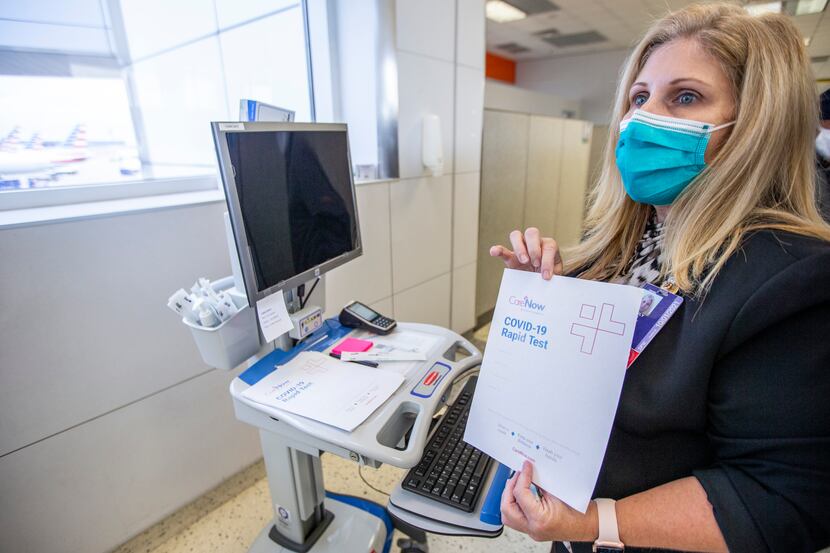Jimmy Sweeney of Fort Worth will take his first flight since the COVID-19 pandemic to visit family in Florida around the Thanksgiving holiday — and he has reasons to be cautious.
He’ll be taking his wife and their 4-month-old baby girl on a Southwest Airlines flight out of Dallas Love Field. And while he’s not worried about getting on a plane, he is worried about being in tight spaces with a large group of family members once he arrives.
“It looks like it will be too big of a crowd for Thanksgiving, so we’ll visit family when we get there and then do our own thing for a week and then see family again later,” said Sweeney, who owns the Grand Berry Theater, an independent movie theater in Fort Worth.
As millions of Americans make plans to travel for the holidays, the COVID-19 pandemic is upending one of the busiest flying periods of the year. Surveys show most people aren’t willing to fly yet and health and government authorities are warning that large family gatherings may be breeding grounds for the spread of the coronavirus.
To combat that, airlines are going to great lengths to convince customers — and governments — that air travel is safe. They’ve adopted pre-flight COVID-19 testing to screen out potentially infected travelers before they board flights and they’ve rolled out studies about the low risk of catching the virus on a plane. Those efforts may open restricted areas to travelers, but as winter approaches, there isn’t any sign the pandemic is going away.
In a year where the pandemic has changed the way we work and go to school, it’s also set to change the way Americans eat turkey and exchange gifts in the presence of family and friends.
It will be the first major test for airlines since the dismal summer travel season ended. Early indications are that the November-December holiday travel season won’t be strong either. The major airlines have cut more than 40% of flights from their previous schedules in anticipation of tepid demand.
Dallas-based Southwest Airlines and Fort Worth-based American have even reduced their flight schedules on the busiest days of the Thanksgiving travel week by about a third compared with a year ago, according to Dallas-based Airline Data Inc.
Still, CEOs at all four major airlines said they have recently seen an uptick in bookings for the peak holiday weeks and are adding flights to match demand.
As leisure travelers slowly return, business travel isn’t expected to bounce back for years. Bank of America research shows that business trips — 400 million in 2019 — contributed $334 billion to the travel industry’s $1.1 trillion in revenue last year. Its researchers don’t see that spending coming back until late 2023 or 2024.
Is it safe to fly?
Sweeney, who plans to spend about two weeks in Florida, said he researched how safe it is to travel on airplanes before booking tickets. With everyone required to wear a mask, he said he feels comfortable.
The new dad said he is worried about those who skirt the rules.
“If there is one joker that decides he doesn’t want to wear a mask after the plane is in the air, then I think I’ll have a problem,” he said.
Airline leaders have been trying to convince passengers for months that upgraded cleaning standards, advanced air filters and mask mandates are enough to significantly reduce the risk of catching COVID-19 while flying. American Airlines CEO Doug Parker said infection rates for flight attendants and pilots is lower than that of the general population and ground employees.
“These are people that are taking three flights a day,” Parker said. “The act of flying itself is extremely safe.”
Airlines say commercial aircraft are safer than other confined spaces because the air flows from ceiling to floor and cycles out every three to four minutes.
United Airlines and the Department of Defense released a study earlier this month using mannequins and sensors that showed the “exposure risk is minimal even during long-duration flights,” and the risk of transmission is low even in middle seats.
The study was meant to identify the safety of planes being used to transport troops and other Department of Defense employees through the U.S. Transportation Command, which often partners with United and other airlines. But the study applies to all commercial airliners, United’s leaders said.
Southwest Airlines, which had been one of the carriers keeping middle seats open, will begin selling those seats again starting Dec. 1.

The International Air Transport Association, the trade group representing commercial airlines, said there have been 44 cases of COVID-19 worldwide tied to airplane flights since the beginning of the pandemic out of about 1.2 billion passenger journeys. There have been close to 41 million cases globally.
While industry-sponsored studies show minimal risk of catching COVID-19 on planes, it’s still unclear how safe they are, partly because it’s often hard to tell where someone contracted the virus, particularly if they got it from an asymptomatic carrier.
“The absence of large numbers of confirmed and published in-flight transmissions of SARS-CoV-2 is encouraging but is not definitive evidence that fliers are safe,” said a study from Dr. David Freedman and Dr. Annelies Wilder-Smith, who helped put together a study on COVID-19 transmission for IATA.
A study from Massachusetts Institute of Technology professor Arnold Barnett showed that the risk of COVID-19 transmission was about 1 in 6,400 for people seated next to one another on an aircraft, about a third higher than the transmission rate for passengers separated by a middle seat.
“If you are on a two-hour flight, the risk is higher than two hours on the ground,” said Barnett, a statistics professor at MIT’s Sloan School of Management. “These airlines that say there is no risk from flying because of their HEPA filtration systems and changing out air every two to three minutes, that’s just not true.”
Southwest, trying to reassure passengers, has partnered with UT Southwestern Medical Center in Dallas and Stanford University. The Mayo Clinic and Vanderbilt University’s medical center also are working with airlines to provide guidance on travel safety.
And the winter months could add a whole new set of complications to containing the contagion.
“Distinguishing the symptoms of COVID-19 and the common flu virus could be difficult,” said Katelyn Gostic, an epidemiologist at the University of Chicago. “But my understanding is that flu circulation has been pretty low so far, maybe because of social distancing.”
Every sniffle, sneeze and cough in an airport or on a plane will be under increased scrutiny.
Adding precautions
The newest line of defense for airlines has been pre-flight COVID-19 testing, opening up flights to places such as Hawaii and the Caribbean. Under the programs, passengers can get tested within 72 hours of flying through tests at home, at urgent care centers or in rapid testing centers at airports.
American Airlines started offering 15-minute COVID-19 testing at DFW International Airport last week through a local urgent care center. The nasal swab tests cost about $250. The tests are required to enter Hawaii without a two-week quarantine.
“We’ve started small, doing Hawaii and looking at some international locations first,” said Kim Cisek, American’s managing director of customer experience innovation and delivery.
It’s a program that could spread. Rapid test centers opened last week at London Heathrow Airport in the United Kingdom. Many places are still off-limits to most travelers. Americans can’t travel freely to the European Union, and New York, New Jersey and Connecticut don’t allow travelers from most states without a two-week quarantine.
On Tuesday, Chicago added travelers from Texas to its list of states where visitors must quarantine for two weeks.
United Airlines, which also has rapid testing facilities at San Francisco International Airport, said its program could expand to other closed-off regions.
“United supports an increased testing regimen in the near term to lower borders and remove quarantines for those that can produce a negative COVID test within 72 hours of departure,” said United Airlines chief commercial officer Andrew Nocella in a call with investors. “We hope that by spring 2021, testing will be widely available and governments around the world will adopt consistent measures to reduce or eliminate quarantines for those that test negative.”
Not going home, but not staying home either
“People are traveling but not going home this holiday season,” said Mel Dohmen, who helped put together a survey for Travelocity. “I think it indicates a lot of what we saw during the summer. People want to go to locations where they can have distance from other people.”
Even fewer people are looking to travel in the Northeast and on the West Coast, regions hit hard and early during the pandemic. In contrast, the southern parts of the country, including Texas, are more likely to travel this holiday season, according to Travelocity’s survey.
And in another quirk of the pandemic, people are opting to stay longer when they travel, she said. Travel experts have said this has become more common when people can work from home, or work from anywhere with a wireless internet connection.
While some people are still skeptical of flying, Dohmen said those who have taken trips since the beginning of the pandemic are most likely to say they’re comfortable with the flying experience.
“If you have taken a trip sometime during the pandemic, you have probably seen everything that is being done and are happy," she said. “But even if you are happy flying, you may not necessarily want to visit family this holiday season.”

